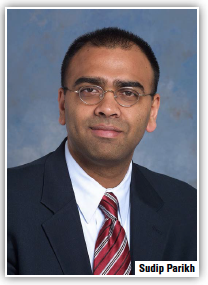Bringing Patients’ Voices to Drug Development
 Sudip Parikh, Senior VP and Managing Director of DIA Americas, talks about the Drug Information Association’s survey of patient-centric initiatives in drug development.
Sudip Parikh, Senior VP and Managing Director of DIA Americas, talks about the Drug Information Association’s survey of patient-centric initiatives in drug development.
PV: What are the notable findings fromDIA’s survey about patient-centricity in drug development?
Parikh: There are three findings I want to highlight. There is a huge variability in patient engagement activities, but when we look at the impact they are having, it turns out that some of the ones that were the least expensive are giving the most bang for their buck. For example, there’s a lot of IT being developed for patient engagement at the clinical trial level and thus far, the impact at least as measured by our survey was not huge. Whereas, the bang for the buck on a patient council or a patient advisory board to a trial or a therapeutic area, has been quite high.
The second finding involves the variability of patient engagement from an organizational structure perspective. There is no standard way of incorporating patient engagement in clinical development.
But the most surprising finding is that there is a disconnect between the C-suite and those within the development organization actually charged with patient engagement. At the C-suite level, patient engagement has been discussed in policy circles for a while. But when we look at the clinical trial level and the individuals who are running the clinical trials, there is a disconnect. Often, there is not the budget to include patient engagement as part of the process. The challenge is making sure the right incentives are in place. At the top of the organization, companies are saying they are very much interested in the patient voice, but at the operational level there are budget targets. An extra spend that does not have a demonstrated or validated output or outcome is hard to justify. The incentives aren’t quite matched up.
PV: How can companies address this disconnect between the C-suite and those at the operational level?
Parikh: Companies need to create a framework so the people at every level of the organization ask the question about the value of patient engagement in a particular trial. This takes time and cultural change. I’d say there is progress toward organizational-wide engagement. Part of the reason is metrics. We need to be able to measure the impact of patient engagement. Without validated metrics, people are operating in the dark.
PV: Why is the patient voice important in clinical research?
Parikh: When patients are involved, there are better outcomes. It makes perfect sense that their voices need to be heard at the company level. We want to develop a product that has the endpoints that patients want and need.
The patient voice also helps to define the problems that need to be addressed. Patients can lend their voice about targets, particularly in diseases that fall into the neglected or orphan disease categories. Sophisticated patient advocacy organizations can also help identify where the scientific opportunities are. This is where patients’ needs and companies’ needs align.
PV: Are current efforts to engage patients in clinical development effective?
Parikh: Anecdotally, yes. I can give you examples of how patient input either had a positive change in timelines or where patient input helped to demonstrate the benefit of a particular therapy.
There are low-cost, low-entry things companies can do to have a positive impact, such as having patient advisory councils for trials. There’s enough data now to validate this impact because there are many companies that have conducted these types of programs. However, we don’t have data yet for e-informed consent among the other IT expenditures that are happening.
PV: What are some good ways to involve patients in trials?
Parikh: It is really important to understand the endpoints that are significant to the patient. This is critical, whether it’s a cholesterol-lowering drug or a cancer drug. A small investment in terms of talking to patients about endpoints and about ways to increase adherence can make a big difference.
Another area is in recruitment. Patients with like diagnoses, because of tools on the Internet, have found each other and they can help recruit others for trials, especially with rare diseases. It’s hard to find patients who have not previously been in other trials. Finding patients through social media or word of mouth now is probably more effective than the old-fashioned recruitment methods because patients know each other.
PV: What are the common themes among those companies that have successful patient engagement programs?
Parikh: Sponsor companies that involve patients early and often are the ones that can show anecdotal impact; this is not necessarily tied to the highest investment cost.
In a few years, as patient engagement becomes more objectively quantified, we can actually say what the attributes of a successful program are for a chronic disease or for an infectious disease.
The key piece is that patient engagement in clinical trials is evolving; we still need validated metrics. There’s a lot more to come in the field. (PV)










